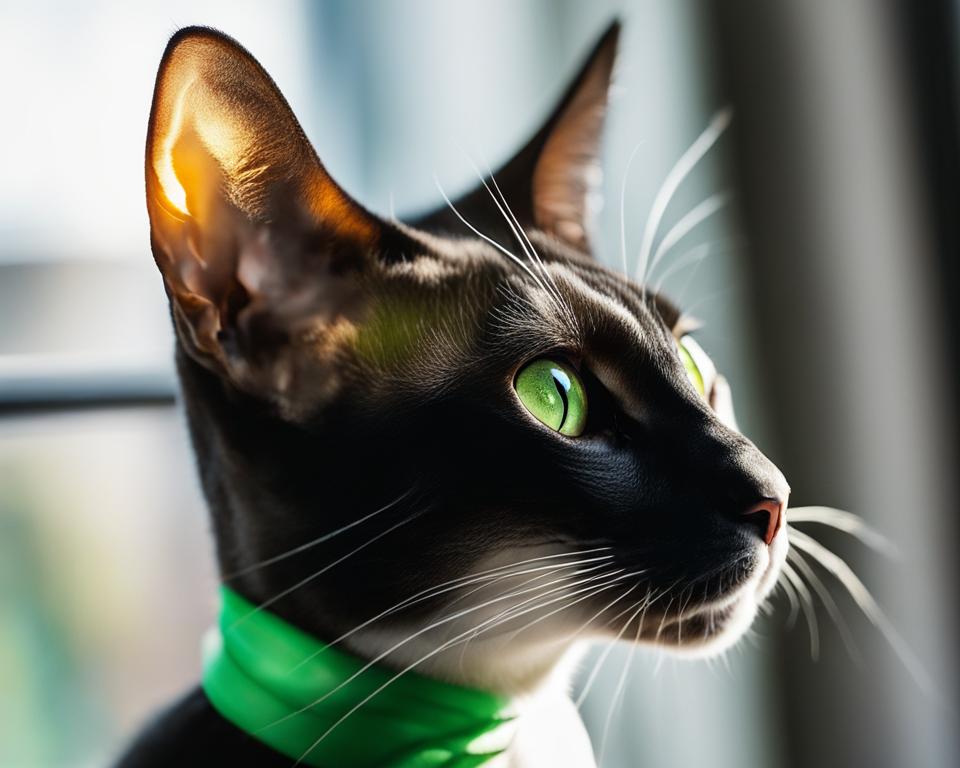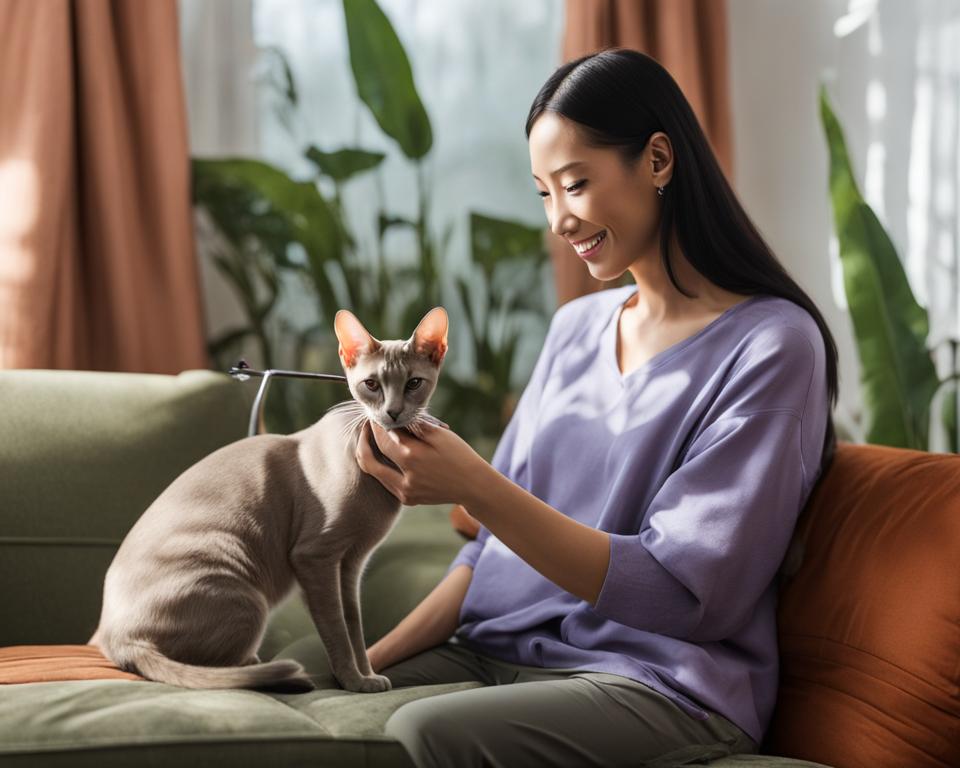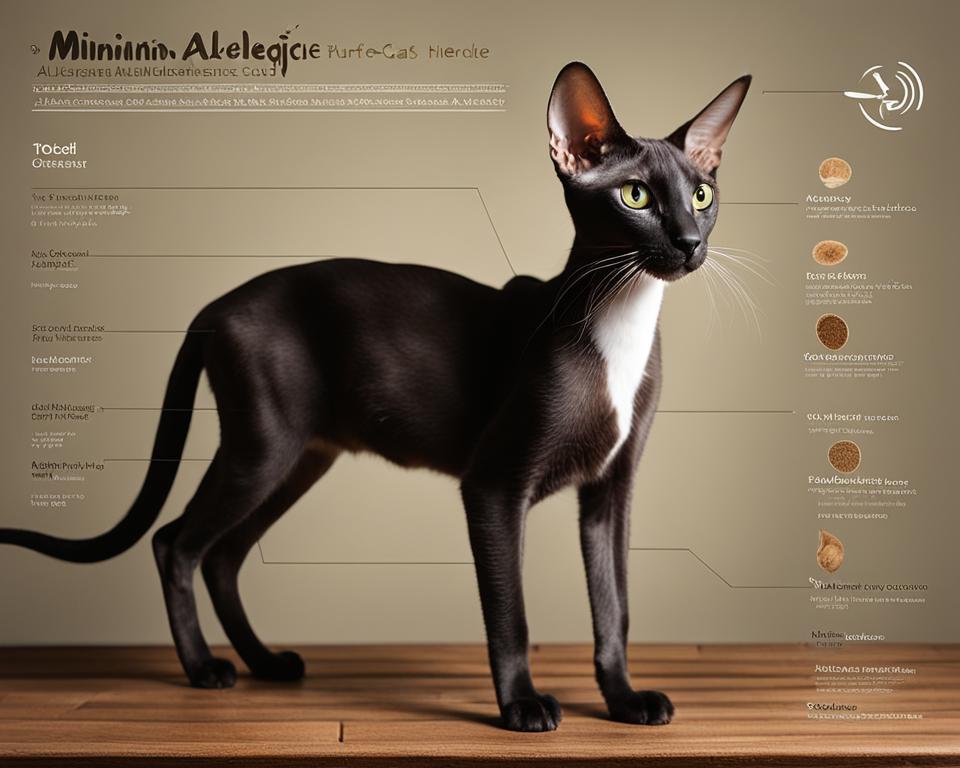Oriental Shorthair cats are a popular choice for cat lovers who struggle with allergies. These elegant felines are closely related to Siamese cats and share similar physical characteristics. However, they come in a wider range of colors, adding a touch of diversity to their striking appearance.
While no cat can be completely non-allergenic, Oriental Shorthairs are considered hypoallergenic due to their low production of the Fel d1 allergen, low shedding rate, and short hair. This makes them a great option for individuals who experience allergic reactions to cats.
Key Takeaways:
- Oriental Shorthair cats are hypoallergenic due to their low production of the Fel d1 allergen.
- They have a low shedding rate, which reduces the amount of allergens in the environment.
- Their short hair is easier to manage and reduces the likelihood of allergic reactions.
- While no cat is completely non-allergenic, Oriental Shorthairs are a suitable choice for people with allergies to cats.
- Proper allergy management techniques can further minimize allergic reactions when living with an Oriental Shorthair.
Are Oriental Shorthair Cats Hypoallergenic?
Oriental Shorthair cats are often hailed as hypoallergenic, making them a popular choice for individuals with allergies. While no cat breed is completely non-allergenic, Oriental Shorthairs have certain characteristics that make them less likely to trigger allergic reactions in sensitive individuals.
One of the main reasons why Oriental Shorthairs are considered hypoallergenic is their low production of the Fel d1 protein, which is the primary allergen found in cat saliva and dander. These cats have lower levels of Fel d1 compared to other breeds, reducing the risk of allergic reactions. Additionally, Oriental Shorthairs have a low shedding rate and short hair, which further minimizes the spread of allergens in the environment.
It’s important to note that individual reactions to cats can vary, and some people may still experience allergies despite the hypoallergenic qualities of Oriental Shorthairs. However, for many allergy sufferers, these cats provide a viable option for enjoying feline companionship without the typical allergy symptoms.
Hypoallergenic Rating
To better understand the hypoallergenic properties of Oriental Shorthair cats, a rating system is often used to assess their allergenicity. Oriental Shorthairs typically score around 7 out of 10 on the hypoallergenic scale, with 10 being completely non-allergenic. This rating takes into account the likelihood of triggering breathing allergies and skin allergies.
| Allergy Type | Likelihood of Allergy |
|---|---|
| Breathing Allergies | 4/10 |
| Skin Allergies | 3/10 |
While Oriental Shorthairs have a relatively low probability of causing breathing allergies, they still have some potential to trigger skin allergies. It’s important for individuals with sensitivities to spend time with an Oriental Shorthair before making a decision to ensure they do not experience any adverse reactions.
In conclusion, Oriental Shorthair cats are considered hypoallergenic due to their low production of the Fel d1 allergen, low shedding rate, and short hair. While they may not be completely allergen-free, these cats offer a viable option for individuals with allergies who still want to enjoy the companionship of a feline friend.
How to Know If Oriental Shorthair Is Hypoallergenic to You
Allergic reactions to cats can vary from person to person, making it important to assess your sensitivity to Oriental Shorthair cats before bringing one into your home. While these cats are considered hypoallergenic, meaning they are less likely to cause allergies, individual responses can still occur. Here are some key factors to consider when determining if an Oriental Shorthair is hypoallergenic to you:
1. Fel d1 Production Rate:
Fel d1 is a protein found in cat saliva and dander that is known to trigger allergies in humans. Oriental Shorthairs produce less Fel d1 compared to other breeds, reducing the likelihood of allergic reactions. However, it is recommended to spend time around these cats to gauge your individual response before making a decision.
2. Hair and Dander:
Cat allergies are often triggered by contact with hair and dander. Oriental Shorthairs have short hair that sheds less, reducing the presence of allergens in your home. Additionally, these cats have a lower dander production rate, which further decreases the risk of allergic reactions.
3. Breathing and Skin Allergies:
When it comes to breathing allergies, Oriental Shorthairs have a lower probability of causing such reactions compared to other breeds. The same applies to skin allergies, as their low shedding rate and low dander production help minimize skin irritation. However, it is essential to note that individual sensitivities may still play a role in allergic responses.
| Hypoallergenic Factor | Likelihood |
|---|---|
| Breathing Allergies | 4/10 |
| Skin Allergies | 3/10 |
To summarize, Oriental Shorthair cats are generally considered hypoallergenic due to their low Fel d1 production, low shedding rate, and short hair. However, individual responses can vary, so it is recommended to spend time with these cats to assess your sensitivity. Additionally, considering factors such as breathing allergies and skin allergies can help determine if an Oriental Shorthair is hypoallergenic to you.
Do Oriental Shorthair Cats Shed a Lot?
Oriental Shorthair cats are known for their sleek and low-maintenance coats, making them a great choice for individuals with allergies or those who prefer a low shedding cat breed. Their short to medium fur length and close-lying coat reduce the likelihood of triggering breathing allergies caused by cat hair. Additionally, Oriental Shorthairs have a shedding rate of 3/10, further minimizing the presence of allergens in the environment.
Grooming plays a crucial role in managing shedding levels in Oriental Shorthair cats. Regular brushing helps remove loose hair and dander, preventing them from spreading around the house. Utilizing a high-quality cat brush or comb will aid in maintaining a healthy coat while reducing the amount of loose hair that can cause allergies.
Grooming Tips for Oriental Shorthair Cats:
- Brush your cat’s coat at least once a week to decrease shedding.
- Use a gentle grooming tool to avoid irritating your cat’s skin.
- Consider using a damp cloth or pet wipes to remove loose hair and dander from your cat’s fur.
- Consult with a professional groomer for specialized grooming techniques and advice.
| Shedding Levels | Description |
|---|---|
| High | 10/10 – Heavy shedding, requires extensive grooming and maintenance. |
| Moderate | 5/10 – Moderate shedding, regular grooming is necessary to manage shedding. |
| Low | 3/10 – Low shedding, minimal grooming required to control shedding. |
| Minimal | 1/10 – Almost non-existent shedding, requires minimal grooming. |
By understanding the shedding levels and implementing proper grooming practices, Oriental Shorthair cat owners can significantly reduce the amount of hair and dander in their homes, creating a more allergy-friendly environment.

Oriental Shorthair Saliva and Dander Levels
When it comes to cat allergies, the proteins present in cat saliva and dander are often the culprits. For individuals with skin sensitivities, exposure to these allergens can trigger allergic reactions. However, Oriental Shorthair cats have characteristics that make them a good choice for those with cat allergies.
Oriental Shorthair cats have a medium-sized body and produce lower levels of the allergenic protein Fel d1 in their saliva compared to other cat breeds. This reduced production of Fel d1 makes them less likely to cause allergies in individuals who are sensitive to cat saliva. Additionally, their low dander production rate further lowers the risk of allergic reactions.
While Oriental Shorthair cats may still groom themselves and lick their fur, their drool and dander have a lower chance of causing allergies compared to other breeds. This can be particularly beneficial for individuals with cat allergies who want to enjoy the companionship of a feline friend without constantly suffering from allergic symptoms.
| Allergen | Oriental Shorthair Cats | Other Cat Breeds |
|---|---|---|
| Fel d1 Levels | Low | Varies |
| Saliva Allergies | Lower likelihood | Higher likelihood |
| Dander Allergies | Lower likelihood | Higher likelihood |
By understanding the saliva and dander levels of Oriental Shorthair cats, individuals with cat allergies can make an informed decision about whether this breed is suitable for them. It’s important to note that while Oriental Shorthairs are considered hypoallergenic, individual reactions may still vary. Spending time with the breed and assessing personal sensitivities is crucial before bringing one into your home.
Tips for Managing Allergies With an Oriental Shorthair Around
If you are an allergy sufferer but still want to enjoy the company of an Oriental Shorthair cat, there are several tips and strategies you can use to manage your allergies effectively. By implementing these cat allergy management tips, you can reduce cat allergens in your home and minimize allergic reactions.
Regular Grooming:
Regular grooming is essential for managing cat allergies. Brushing your Oriental Shorthair cat regularly helps to remove loose hair and dander, reducing the amount of allergens in your home. It is also recommended to bathe your cat regularly using hypoallergenic cat shampoos that are specifically designed to minimize allergens.
Fortify Your Home:
To create an allergy-friendly environment, consider using HEPA (High-Efficiency Particulate Air) filters in your home. These filters can effectively capture allergens such as cat hair and dander from the air. Additionally, make sure to keep your home clean and free of dust by regularly vacuuming and dusting the surfaces.
Reduce Allergen Exposure:
Reducing allergen exposure is key to managing allergies with an Oriental Shorthair around. Avoid allowing your cat into your bedroom or other areas where you spend a significant amount of time. Keep your Oriental Shorthair’s living area well-ventilated and use hypoallergenic bedding materials. It is also recommended to wash your hands after touching your cat to minimize allergen transfer.
| Tip | Description |
|---|---|
| Regular Grooming | Brush your cat regularly and bathe them using hypoallergenic shampoos to reduce allergens. |
| Fortify Your Home | Use HEPA filters and keep your home clean to minimize allergens in the air and on surfaces. |
| Reduce Allergen Exposure | Keep your cat out of certain areas, ensure good ventilation, and wash your hands after contact. |
By following these tips, you can create a more allergy-friendly environment and enjoy the companionship of your Oriental Shorthair cat without suffering from severe allergic reactions. Remember, everyone’s allergies are unique, so it’s essential to find the approach that works best for you and consult with your healthcare professional if needed.

Conclusion
Considering the unique characteristics of Oriental Shorthair cats, they are often classified as hypoallergenic. However, it’s important to note that individual reactions to allergies may vary. It is highly recommended to spend time around Oriental Shorthairs before making a decision to ensure compatibility with your sensitivities.
To further reduce the risk of allergies, regular grooming and coat maintenance are crucial. This helps in minimizing the presence of allergens such as dander and saliva. By adopting proper allergy management techniques, Oriental Shorthair cats can make excellent companions for those who suffer from cat allergies.
In conclusion, while Oriental Shorthair cats are considered hypoallergenic, it is essential to understand that no cat breed is entirely non-allergenic. By taking necessary precautions and implementing effective allergy management strategies, you can create a harmonious environment with your beloved Oriental Shorthair cat without compromising your health.
FAQ
Are Oriental Shorthair Cats Hypoallergenic?
While no cat is completely non-allergenic, Oriental Shorthairs are considered hypoallergenic due to low Fel d1 production, low shedding rate, and short hair.
How to Know If Oriental Shorthair Is Hypoallergenic to You
It is best to spend time around this breed before making a decision. Proper grooming and coat maintenance can also lower the risk of allergies.
Do Oriental Shorthair Cats Shed a Lot?
Oriental Shorthair cats are low shedding creatures. They have short to medium fur length and a sleek coat that lies close to their body. With proper grooming, their shedding levels can be further reduced.
Oriental Shorthair Saliva and Dander Levels
Oriental Shorthairs have a low likelihood of causing allergies due to their low Fel d1 production rate and low dander production rate. While they may still lick themselves clean, their drool and dander have a lower chance of causing allergies.
Tips for Managing Allergies With An Oriental Shorthair Around
Training the cat, fortifying the home, and reducing allergen exposure can help minimize allergic reactions. Regular grooming, using HEPA filters, and changing bedding regularly can also reduce the allergens in the home.
Conclusion
Oriental Shorthair cats are considered hypoallergenic, but individual reactions may vary. They make great companions for allergy sufferers with proper allergy management techniques in place.

Leave a Reply